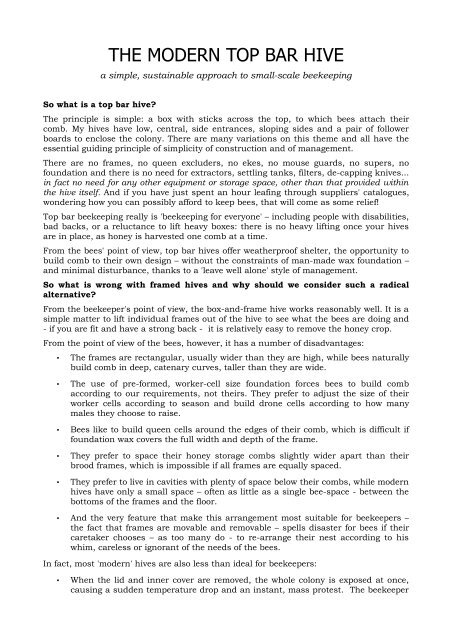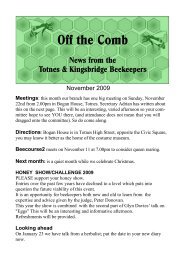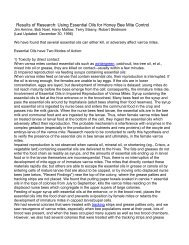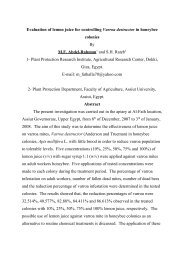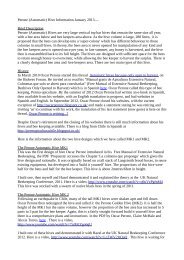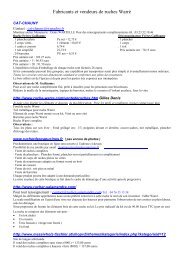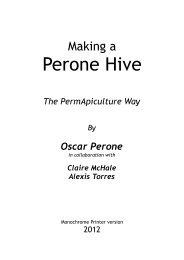THE MODERN TOP BAR HIVE - BioBees
THE MODERN TOP BAR HIVE - BioBees
THE MODERN TOP BAR HIVE - BioBees
You also want an ePaper? Increase the reach of your titles
YUMPU automatically turns print PDFs into web optimized ePapers that Google loves.
So what is a top bar hive?<br />
<strong>THE</strong> <strong>MODERN</strong> <strong>TOP</strong> <strong>BAR</strong> <strong>HIVE</strong><br />
a simple, sustainable approach to small-scale beekeeping<br />
The principle is simple: a box with sticks across the top, to which bees attach their<br />
comb. My hives have low, central, side entrances, sloping sides and a pair of follower<br />
boards to enclose the colony. There are many variations on this theme and all have the<br />
essential guiding principle of simplicity of construction and of management.<br />
There are no frames, no queen excluders, no ekes, no mouse guards, no supers, no<br />
foundation and there is no need for extractors, settling tanks, filters, de-capping knives...<br />
in fact no need for any other equipment or storage space, other than that provided within<br />
the hive itself. And if you have just spent an hour leafing through suppliers' catalogues,<br />
wondering how you can possibly afford to keep bees, that will come as some relief!<br />
Top bar beekeeping really is 'beekeeping for everyone' – including people with disabilities,<br />
bad backs, or a reluctance to lift heavy boxes: there is no heavy lifting once your hives<br />
are in place, as honey is harvested one comb at a time.<br />
From the bees' point of view, top bar hives offer weatherproof shelter, the opportunity to<br />
build comb to their own design – without the constraints of man-made wax foundation –<br />
and minimal disturbance, thanks to a 'leave well alone' style of management.<br />
So what is wrong with framed hives and why should we consider such a radical<br />
alternative?<br />
From the beekeeper's point of view, the box-and-frame hive works reasonably well. It is a<br />
simple matter to lift individual frames out of the hive to see what the bees are doing and<br />
- if you are fit and have a strong back - it is relatively easy to remove the honey crop.<br />
From the point of view of the bees, however, it has a number of disadvantages:<br />
• The frames are rectangular, usually wider than they are high, while bees naturally<br />
build comb in deep, catenary curves, taller than they are wide.<br />
• The use of pre-formed, worker-cell size foundation forces bees to build comb<br />
according to our requirements, not theirs. They prefer to adjust the size of their<br />
worker cells according to season and build drone cells according to how many<br />
males they choose to raise.<br />
• Bees like to build queen cells around the edges of their comb, which is difficult if<br />
foundation wax covers the full width and depth of the frame.<br />
• They prefer to space their honey storage combs slightly wider apart than their<br />
brood frames, which is impossible if all frames are equally spaced.<br />
• They prefer to live in cavities with plenty of space below their combs, while modern<br />
hives have only a small space – often as little as a single bee-space - between the<br />
bottoms of the frames and the floor.<br />
• And the very feature that make this arrangement most suitable for beekeepers –<br />
the fact that frames are movable and removable – spells disaster for bees if their<br />
caretaker chooses – as too many do - to re-arrange their nest according to his<br />
whim, careless or ignorant of the needs of the bees.<br />
In fact, most 'modern' hives are also less than ideal for beekeepers:<br />
• When the lid and inner cover are removed, the whole colony is exposed at once,<br />
causing a sudden temperature drop and an instant, mass protest. The beekeeper
tries to silence this revolt by applying liberal doses of smoke, which, as often as<br />
not, aggravates the bees rather than subduing them, with painful and disruptive<br />
consequences.<br />
• Frames are made to precise dimensions, which means that they must be<br />
purchased - at no small cost - from manufacturers equipped with expensive,<br />
precision machinery and laboriously assembled with hammer and pins. They are<br />
easily damaged by rough handling and are difficult to clean thoroughly.<br />
• Foundation wax also has to be bought in - as precision mills cost a king's ransom<br />
– and fitted carefully into the frames with more pins and wire.<br />
• The wax used for making foundation will contain a random mix of all the lipophilic<br />
substances that previous beekeepers have chosen to apply, as it is bought in by<br />
the millers from whoever cares to sell it to them. This may include sources that<br />
are less than scrupulous about the chemicals and medications they use.<br />
• Then, when it comes to harvest time, we have the problem of weight. A full super<br />
of honey can weigh between thirty and sixty pounds, depending on the type of hive<br />
and number of frames. Not surprisingly, hernias and chronic back pain are<br />
commonplace among commercial beekeepers and many people, especially women,<br />
are put off even hobby-scale beekeeping by this consideration alone.<br />
Top bar beekeeping is about as simple as beekeeping can get, while maintaining<br />
provision for occasional inspections, comfortable over-wintering and non-destructive<br />
harvesting. Everything you need is in one box – the beehive – which you can make<br />
yourself.<br />
Top bar beekeeping can produce plenty of honey, but the emphasis here is on<br />
sustainability and keeping healthy bees rather than setting records for honey crops,<br />
which inevitably has a cost to the welfare of the bees. The essence of sustainability is to<br />
work well within the limits of a natural system: pushing any living thing beyond its<br />
natural capacity can only lead to trouble.<br />
In my book, The Barefoot Beekeeper, I describe the top bar hive and its management and<br />
discuss the philosophy of natural beekeeping, in which we aim to work with the natural<br />
impulses and habits of the bees, respecting the integrity of the brood chamber, leaving<br />
them ample honey stores over winter and generally arranging things in order to cause<br />
their bees as little stress and disturbance as possible.<br />
I hope soon to be able to welcome you to our Natural Beekeeping Forum, which has<br />
members from around the world who have chosen this most fascinating way to provide<br />
homes for honeybees and have a sustainable crop of honey.<br />
Philip Chandler<br />
Free DIY plans for building a top bar hive are available from the author's web site at<br />
www.biobees.com The Barefoot Beekeeper is also available from this site, as well as from<br />
Amazon or any bookseller using the ISBN 978-1-4092-7114-7.<br />
The Natural Beekeeping Network discussion forum is at www.naturalbeekeeping.org<br />
Friends of the Bees is a charity founded to conserve and protect bees and to research<br />
and promote more natural beekeeping methods. We aim to work with others to help<br />
restore the natural balance between honeybees and other insect pollinators. See<br />
www.friendsofthebees.org for more information.


